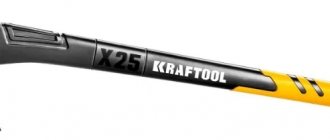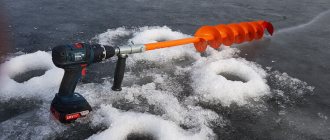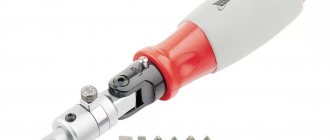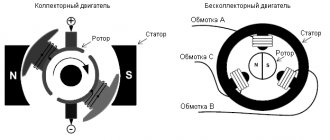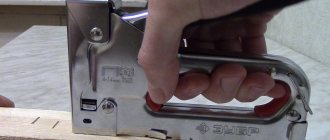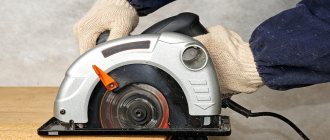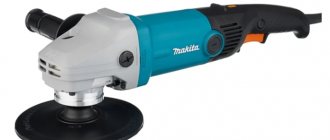| Place | Name | Characteristics in the rating |
| TOP 10 best screwdriver sets |
| 1 | BAHCO Fit B219.006 | Truly European quality. Two-component handles |
| 2 | Felo Smart 06391306 | Universal set for electricians. 12 replaceable bits |
| 3 | Wera Kraftform Kompakt VDE WE-135906 | Torque holder included. Piece-by-standard inspection |
| 4 | Xiaomi Wiha 26 in 1 ScrewDriver Kit 77790 | Unique rod storage. Reliable material |
| 5 | JONNESWAY Full Star D04PP08S 47072 | The most popular type of tools. Lifetime Warranty |
| 6 | Kraftool 25616-H12 | The best set in the budget segment for repairing mobile phones |
| 7 | Bison Master Universal 27 25027 | The best price-quality ratio from a domestic manufacturer |
| 8 | Matrix Fusion 11452 | A set for all occasions. Table stand |
| 9 | HAMA H-39694 | Practical mini screwdriver set. Thoughtful design |
| 10 | Gross 12164 | Better handle ergonomics. Indestructible slots |
TOP 10 best screwdriver sets
As expected, the first places are taken by products from long-recognized and respected brands. You won’t be able to save money on their purchase, but they are worthwhile tools that can withstand increased loads over a long service life. Screwdriver sets from Taiwanese and Chinese manufacturers are much more affordable, and they are optimal for infrequent use in the home. At the end of the rating are the cheapest options, the quality of which is in no way comparable to the leaders, but they are quite suitable for solving one-time tasks.
Bits and sockets
Let's talk directly about the working elements of sets with reversible screwdrivers - socket heads and bits.
In fact, they are removable tips of ordinary screwdrivers.
Device and purpose of bits
Bits are replaceable tips (nozzles) for screwdrivers.
They are intended for screwing and unscrewing fasteners. One side has a slot for a specific type of fastener, and the part that is inserted into the screwdriver is a hexagon in cross section.
This shape allows the bits to be used when working with a power tool, for example, a screwdriver.
These nozzles are shaped like a solid cylinder.
Bits with a common slot type are usually sold as part of a set.
Special ones or with a rarer slot can be purchased individually.
The most popular bits can be found by the following markings:
• Standard PH (Phillips) - cross-shaped slot with four types of sizes, from PH0 to PH3. The most common size is PH2.
• Standard PZ (Pozidriv) - a cross-shaped slot, reminiscent of PH, but with additional smaller “blades” (at an angle of 45 degrees to the main ones).
• Standard SL (Slot) - Flat slot. Next to the letters there are usually numbers corresponding to its size.
• Torx standard (hex star). Next to the letter marking “T” are numbers corresponding to the size in millimeters, for example, T30.
Bits for precision work
When repairing watch movements or compact electronics such as mobile phones, bits are used for precision work.
They are significantly smaller than the usual options, but they are standardized in the same way.
On the marking next to the letter designation of the spline type, its size is indicated.
Socket heads
The socket heads for screwdrivers look exactly the same as the options for ratchet wrenches.
They are made in the shape of a “barrel” (sometimes they are called that), where on one side there is a hole - a slot of the appropriate size, and on the other - a square hole for the tool adapter.
As a rule, the size of the head for screwdrivers is limited to No. 13.
This is due to the fact that larger bolts and nuts require a force that:
• can damage the screwdriver • can only be applied with a wrench due to the larger lever
The most common types of socket heads:
• Hexagonal - working profile in the shape of a hexagon. The most popular option.
• Dodecahedron - have a working profile in the form of a dodecahedron. Suitable for use with hex and twelve-point fasteners.
• SuperLock (SL) - the working profile is similar to a hexagon, but with an increased contact area with the fastener.
Designed to work with torn (licked) edges of the fastener head.
• Universal - the working profile is made in the shape of a dodecahedron with cut off (blunt) vertices. Suitable for working with various profiles (both metric and inch) of fastener heads.
Adapter for socket heads
Since the socket heads have a hole for fastening, and not a protruding hexagon, a special adapter is needed to work with them with a reversible screwdriver.
It can be either monolithic or hinged, which allows you to work with bolts and nuts at an angle.
What is an impact driver and what is it used for?
In appearance, an impact screwdriver is not much different from a regular screwdriver - the only difference is that it is somewhat “thicker”. The need to make the body of this screwdriver as such did not arise by chance. After all, this screwdriver takes hammer blows during operation, so it needs two things - for the body to be strong, and for this its area is increased. And, secondly, the screwdriver is deliberately made wide, so that during impacts, the risk of hitting your hands is significantly reduced.
The purpose of an impact screwdriver is, in principle, no different from a conventional tool - it is necessary for tightening or unscrewing fasteners. However, in this case, there is some peculiarity, because with this screwdriver you can unscrew “welded” and “stuck” screws and screws by striking the screwdriver. Thus, with each blow on the tool, it makes a slight turn in one direction or another, depending on whether you need to tighten the screw or loosen it. Therefore, having installed it in the correct position, it is necessary to strike, thereby twisting or unwinding the fastener.
Design
Revolving mechanism for changing attachments
The main feature of the Gross screwdriver, which makes it so unusual and noticeable, is the revolving mechanism for changing bits.
There are five bits loaded in the drum - three Phillips and two slotted. Switching between bits is like reloading a pump-action shotgun. You pull the handle, the bit is recessed inside the drum, you rotate the drum, select the desired slot and slam the handle, the selected bit rises to the working position. The surroundings and sound are appropriate.
The procedure for reloading the bits in a screwdriver is so impressive that a demonstration in the office among colleagues did not leave indifferent even those who are usually uninterested in all these “men’s pieces of hardware.”
Stash in the handle
The internal volume of the screwdriver body is used to the fullest with German rationality. Since there is access to it - when recharging the bit, the inside opens up to a generous 80 millimeters - which means it must be filled.
Hence the secret compartment. Which stores…
... four more bits: two with Torx profile and two with Hexagon.
...and a bit adapter with built-in magnet. It adds an additional 33 millimeters to the effective length of the screwdriver.
Bits
In addition to the revolving mechanism, the Gross screwdriver has a second significant advantage. The bits are made of S2 tool steel.
S2 is considered the best choice for screwdrivers and bits. It has a complex composition, which includes silicon and molybdenum. This steel holds the load well, but has a limited margin for reversible deformation. In other words, when the limit is reached, it is destroyed.
However, Gross works with regular chrome-vanadium bits without any problems. They are also held in place by built-in magnets and are placed in the drum.
Reversible ratchet mechanism
A reversible ratchet mechanism is installed in the front part of the screwdriver. Switching is clear, without jamming or false positives. The transition to each of the three positions is accompanied by a noticeable click.
Lever
We have already noted that the handle in the reversible screwdriver is round and massive. According to the manufacturer, this was done intentionally to enhance the torque transmitted from the hand to the fastener by enlarging the contact patch between the palm and the handle.
The handle is made of hard plastic covered with a rubber protector.
Since the screwdriver body is essentially collapsible, flat surfaces are provided inside to transmit rotation from the handle to the bit.
The play between the handle and the body, inevitable with such a design, is about two millimeters.
Handle modifications
Not only the convenience, but also the scope of its application depends on the shape of the screwdriver handle. There is a familiar, and probably the very first, shape of a screwdriver - a straight one, which has a wide range of applications due to the variety of sizes. But there are also improved forms of the handle that greatly simplify the use of a screwdriver.
- Screwdriver with T-handle. Not all work can be done using a straight-handled screwdriver; it is versatile, but has limitations. If you need to transfer a lot of torque to a part, it is advisable to use a screwdriver with a T-handle. The closer it is to the T-shape, the greater the leverage and the greater the moment of force will be. The handle can be additionally equipped with a hinge, which allows you to change the angle between the axis of the screwdriver rod and the axis of the handle, thereby adjusting the length of the lever. Such screwdrivers can have interchangeable attachments, which makes them universal.
- L-shaped screwdriver. Otherwise they are called L-shaped keys. They have a hexagonal slot or a slot in the shape of a six-pointed star - TORX. To be able to work at certain angles, they can be additionally equipped with spherical tips.
- Fracture screwdriver. The handle of such a screwdriver can be “broken” and fixed in the position you need, or even in several. Thus, it can imitate a T- or L-shaped handle, which makes it universal and very comfortable.
Additional features
Modernized screwdrivers are quite in demand, as they make it easier to work in non-standard situations and highly specialized areas of the economy.
- Ratchet screwdriver (reversible). It is easy to recognize by its sound (ratchet). The rod rotates freely, and there is no need to intercept the handle. Using the switch lever, you can use such a screwdriver to both unscrew and screw in the components of threaded connections. If you put the switch in the neutral position, this screwdriver turns into a regular one.
- Telescopic screwdriver. Made on the principle of a telescopic fishing rod. Its length can be adjusted and fixed.
- Impact screwdriver. Helps unscrew a screw that is stuck for some reason. These screwdrivers are made from especially strong steel. On the back of the handle there is a steel impact pad or flat shank, which transforms the impact force into rotational force.
- Dielectric screwdriver. An indispensable tool for electricians. The rod and handle are covered with a special insulating material. Only the tip is exposed. This tool can be used to unscrew high voltage parts.
- Screwdriver with flexible shaft. It is possible to change the angle of the rod and work in the most difficult to reach places.
- Cordless screwdriver. A kind of mini-screwdriver. The screwdriver's handle has a built-in battery, so you don't need to use any effort other than to properly guide and hold the tool.
- Clock screwdriver. Probably the smallest one produced in our time. The size of its tip is less than a millimeter. The upper part of the handle is flat and rotating. This makes it possible to hold it with your finger. Used when working with small parts of watches and electronic devices.
- Torque screwdriver. High precision device. It controls the force put into each puff and displays all the data on the screen, which is built into the handle. This allows all threaded connections to be screwed in with the same force. Used in aviation, mechanical engineering, bridge construction, and astronautics.
- Indicator screwdriver. It is used to evaluate the voltage phase during electrical installation work.
It is quite possible that another non-standard screwdriver will be invented soon. Or they upgrade one of the existing types. In the 21st century, everything happens very quickly. But for now, you need to figure out what is already available on store shelves, and, if possible, choose the best for yourself. Therefore, let's summarize all of the above.
Types of screwdrivers
What types of screwdrivers there are can be represented by a fairly large list. You should consider popular and highly specialized types of screwdrivers.
Dielectric
To work with electrical equipment, use a dielectric screwdriver. It does not allow current up to 1000 V to pass through it. The entire instrument is covered with special plastic up to the tip. Electricians use such OSHs to work in electrical cabinets and switchboards.
Tool with dielectric coating
Reversible
The sonic screwdriver is equipped with ratcheting mechanisms. When the tip rotates, the ratchet makes a ratcheting sound. The tool can only rotate in one direction. To turn on the reverse mode, move the lever. Thanks to this device, the master tightens or unscrews the screw without removing the tip from the fastener slots. Reversible tools are otherwise called minus screwdrivers.
Reversible screwdriver
Hexagon
Hexagon-shaped screwdriver slots allow you to apply maximum force to the tool without fear of cutting off the edges of the tip or slots. Fasteners are used in places where the requirements for the strength of the connection of parts are especially high.
Star-shaped
Star-shaped splines are especially popular in the countries of the American continent. In European products for various purposes, star screws are quite common in electronic devices. Their use is subject to the same requirements as for hexagonal tips.
Square
A square-shaped slot is not found in everyday life. Hardware with square openings in the heads is used for mounting parts of special equipment, including in the defense industry.
U-shaped OS
Tools with double tips are called spanners. They are used in elevator facilities. The complex configuration of the tips is aimed at preventing incidents of vandalism in elevator cabins.
Fork
Similar to U-shaped screwdrivers, except that instead of two blades, they have a triple tip. This is a purely professional tool. Screws with such slots are not found in everyday life.
Triangular
Triangular screwdrivers are professional tools. Triangle screwdrivers are compatible with slotted screws that have a similar configuration. Triangular screwdrivers are used for opening and installing panels where access to cabinets and panels with electrical or other equipment is limited.
For One-way slot
The name One-way translated from English means “one way path”. Unscrewing hardware with such a head is only possible with a special tool. Any use of other types of tips results in cutting off the splines. The fastener resists unauthorized entry into various devices.
Bristol
The shape of the spline resembles a six-pointed gear. You can unscrew such hardware only with a Bristol tip. Otherwise, the slot is destroyed and the screw has to be drilled out. Hardware can be found in radio electronics service centers. They are used to protect against vandal penetration into devices.
For Torg-Set slot
The tip is made for a slot in the form of a cross with an offset center. Hardware with such splines is practically not found in Russia.
For muna Torx slot
Screwdrivers for this type of slot have a tip in the form of a six-pointed star. They are necessary in workshops where mobile phones and various gadgets are repaired.
For star spline
The star tip is designed for screws with six-pointed star slots. The stars have sharper peaks. The scope of application is the same as that of the previous type of tool.
It is important to distinguish between the last two types, because using PZ for screws with PH slots can damage the self-tapping screw. As a result, the fasteners will have to be drilled out, the screwdriver itself will fail
Splines and tips
Note! If you have to deal with soured hardware, use an impact screwdriver. It is equipped with a thick metal cap at the end of the handle that can withstand hammer blows
When struck, the tip of the tool rotates with powerful force.
Equipment
The features of the splines are discussed in detail above, so we will focus on the remaining components of the kit - the handles and rods.
Handles
Handles are made of plastic or polycomposite. To reduce slipping, a rubber coating, recesses or notches are used. The coating makes the tool ergonomic and comfortable.
- The ratchet mechanism is an attachable ratchet handle similar to those used in compound socket wrenches. During operation, the rod and tip rotate freely, and the handle remains motionless in the hand.
The model does not require unnecessary movements, therefore it is optimal for large-scale work.
- T-shaped - Swivel type models with a curved or solid top that supports the installation of an auxiliary arm.
- With a heel - most often found in impact screwdriver sets. Instead of recessing into the handle, a through stroke is used. The rod at the end free from the nozzle has a thickening - a heel, which softens the load from blows with a hammer.
Modified handles make screwing/unscrewing easier or increase torque. Most often, functionality is set by a button or reverse switch on the handle.
Rods
Shaft modifications allow you to add additional functionality to the tool.
- Non-standard length - elongated or shortened models of screwdrivers. Length restrictions apply to the shaft and handle. Suitable for processing hard-to-reach places. More often found in combo or flexible models.
- With a tip change function - the tool in this configuration is equipped with a ratchet mechanism or a standard handle. The option without a mechanism involves the use of a universal combo rod. For splines of such models, the kit includes replacement bits.
- Faceted rod - option with a square or hexagonal cross-section (standard - round). Supports the use of leverage to add torsional force. The lever is the tool at hand.
Bits and sockets are typical bit attachments.
There are magnetic models that support the grip of fasteners in inconvenient conditions. External parameters correspond to standard types of splines.
Tip (sting)
The shape of the screwdriver tip should match the shape of the slot - the groove on the head of the screw or screw. Previously, the most common was a straight slot, but now fasteners with it are increasingly difficult to find, which is why not many straight screwdrivers are produced.
Now the most common is the Phillips slot (also called Phillips). There is also an improved version called Pozidriv. Such slots allow you to achieve greater torque, and the screwdriver tip does not fall out of them as easily as from a straight slot.
There are also hex splines and Torx splines (six-pointed star). They are designed for even greater loads.
Other types of slots can be classified as rare, and we advise you to buy screwdrivers with the appropriate tip shape only if necessary.
In addition to the shape of the tip, you need to pay attention to its size. Ideally, a specific tip size should be used for a specific slot size
Many people ignore this instruction and consider, say, a Phillips screwdriver to be universal, suitable for any Phillips slot. If you choose the wrong tip size and shape, you can break the tool or cut off the slot.
How to choose screwdriver size:
- Flat-head screwdrivers are marked with the Latin letters SL, followed by the width of the slot in millimeters. The width of a flat-head screwdriver can be from 2 to 18 mm; as its width increases, the thickness of the tip also increases. For most everyday tasks, the average user can get by with three flat-head screwdrivers of different sizes, say SL3, SL5 and SL8.
- Phillips screwdrivers are marked with PH symbols with a serial number (000; 00; 0; 1; 2; 3; 4). The most popular screwdrivers are PH2 size; they are suitable for most self-tapping screws and self-tapping screws used in everyday life.
The tip of the screwdriver must not only have the appropriate shape and size, it must be strong, hard, not brittle, and securely fixed in the slot. Achieving strength characteristics is facilitated by high-quality rod material and proper heat treatment.
In order for the tip to be securely fixed in the slot, it must be rough. The tips of high-quality screwdrivers are coated with a special coating with a high coefficient of friction, or notches are applied to its edges.
Characteristics
The characteristics of a tool can be read by its full markings. For example, SL1*80 is a flathead screwdriver with a 5mm diameter blade, 80mm long, suitable for fasteners with a diameter of less than 3mm.
| Number | Rod Ø | rod length | Ø fastener |
| №0 | 4 mm | less than 80 mm | less than 2 mm |
| №1 | 5 mm | 80–100 mm | 2.1–3 mm |
| №2 | 6 mm | 100–120 mm | 3.1–5 mm |
| №3 | 8 mm | 120–150 mm | 5.1–7 mm |
| №4 | 10 mm | 150–200 mm | 7.1 mm and more |
In combination with the type marking (SL, HEX, PH, etc.), the table gives a complete picture of the characteristics and application features of a particular tool. Sometimes the marking is supplemented by an indication of the metal alloy from which the slot is made.
